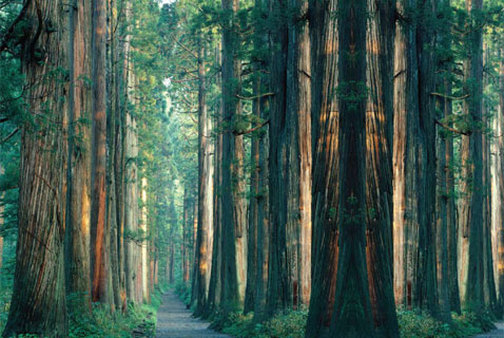Western Red Cedar

The Western Red Cedar
Rich treasure of life
Holding the talents of centuries
Strong, giving, enduring
Growing gently into old age
The path through the Northwest woods ambles past many clusters of Western Red Cedars. They seem to grow best in family groups. Usually the eldest has a place of prominence. The cedar was deeply, almost religiously revered by the early Native Americans of our area. They cradled their babies on it. When they died, they were buried amidst its branches. They used it to make their homes, canoes, paddles, food bowls. They shredded it and then wove it to make rain hats, skirts, other clothing and baskets. They used it to carve huge storytelling poles and placed them outside their lodges. Even in our own culture, the cedar is prized for chests and closets. Its rich smell deters insects, but to our nostrils gives a pleasant scent. The chips and mulch are used by gardeners to reconstitute or ornament their landscapes.
Although shallow rooted, these rain gulping giants of the forest can live for centuries. Left alone, they can grow to gigantic dimensions in width and reach to great heights, possibly only bested in this region by the Giant Sequoia redwoods. However, here in wet Washington, the cedar is clearly the dominant tree. Once it becomes established, very little grows beneath or beside it well. However, a young cedar starts slowly and requires the cover of alders and big leaf maples and even the sun loving Douglas firs to give it enough shade to flourish.
The cedars’ will to live is phenomenal. They resist fire, penetration by insects, diseases. If part of the tree becomes infected, the other sectors strengthen. Even if cut down, any small branch may become another full tree. The stump itself may become a nursery log to seedlings. On one walking path is an old cedar that at one time completely twisted around, so that the trunk literally swirls. Part of its core is riddled with ants, but it persists. As a true monarch, it is regally separate from its much younger family members, but its branches reach skyward from the hollow that it protects. Hands have stroked it over the years, so that some of the tree bark is red, rather than a dull brown. Silently, it gives continuously its gifts - fresh air, clean water, beauty and so much more. Its acts, its presence seem like friendship.
"A faithful friend is the medicine of life."
~ Apocrypha
en.wikipedia.org/wiki/Thuja_plicata
plants.usda.gov/plantguide/pdf/cs_thpl.pdf
Rich treasure of life
Holding the talents of centuries
Strong, giving, enduring
Growing gently into old age
The path through the Northwest woods ambles past many clusters of Western Red Cedars. They seem to grow best in family groups. Usually the eldest has a place of prominence. The cedar was deeply, almost religiously revered by the early Native Americans of our area. They cradled their babies on it. When they died, they were buried amidst its branches. They used it to make their homes, canoes, paddles, food bowls. They shredded it and then wove it to make rain hats, skirts, other clothing and baskets. They used it to carve huge storytelling poles and placed them outside their lodges. Even in our own culture, the cedar is prized for chests and closets. Its rich smell deters insects, but to our nostrils gives a pleasant scent. The chips and mulch are used by gardeners to reconstitute or ornament their landscapes.
Although shallow rooted, these rain gulping giants of the forest can live for centuries. Left alone, they can grow to gigantic dimensions in width and reach to great heights, possibly only bested in this region by the Giant Sequoia redwoods. However, here in wet Washington, the cedar is clearly the dominant tree. Once it becomes established, very little grows beneath or beside it well. However, a young cedar starts slowly and requires the cover of alders and big leaf maples and even the sun loving Douglas firs to give it enough shade to flourish.
The cedars’ will to live is phenomenal. They resist fire, penetration by insects, diseases. If part of the tree becomes infected, the other sectors strengthen. Even if cut down, any small branch may become another full tree. The stump itself may become a nursery log to seedlings. On one walking path is an old cedar that at one time completely twisted around, so that the trunk literally swirls. Part of its core is riddled with ants, but it persists. As a true monarch, it is regally separate from its much younger family members, but its branches reach skyward from the hollow that it protects. Hands have stroked it over the years, so that some of the tree bark is red, rather than a dull brown. Silently, it gives continuously its gifts - fresh air, clean water, beauty and so much more. Its acts, its presence seem like friendship.
"A faithful friend is the medicine of life."
~ Apocrypha
en.wikipedia.org/wiki/Thuja_plicata
plants.usda.gov/plantguide/pdf/cs_thpl.pdf
